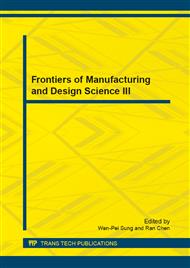[1]
X.Z. Geng, Plastic mixing and continuous mixing equipment, Beijing: China Light Industry Press,2008.
Google Scholar
[2]
P.A. Fleury, Bulk polymerisation or copolymerisation in a novel continuous kneader reactor, Macromolecular Symposia.243(2006) 287-29.
DOI: 10.1002/masy.200651127
Google Scholar
[3]
U.W. Daniel, Axial Transport in Kneader Reactors, In Proceedings of the Society of Plastics Engineers Annual Technical Conference: Plastics Encounter at ANTEC 2007, 1(2007) 502-508.
Google Scholar
[4]
Y.X. Zhang, T. Lu, B. Jiang, K.S. Wang, B. Luo, Numerical Simulation of Polymer Melting during Preheating in Twin-screw Extruder, Journal of Mechanical Engineering, 45(2009)46-49.
DOI: 10.3901/jme.2009.04.046
Google Scholar
[5]
A. Khalifeh, J.R. Clermon, Numerical Simulations of Non-isothermal Three-dimensional Flows in an Extruder by a Finite-volume Method, Non-Newtonian Fluid Mech., 126(2005)7-22.
DOI: 10.1016/j.jnnfm.2004.12.002
Google Scholar
[6]
A.A. Tatarnikov, L.V. Burtelov, D.B. Gorbunov, Effect of Leakage Flow on Processing of Resinous Mixtures in the Pressure Zone of an Extruder, Chemical and Petroleum Engineering, 41(2005)174-179.
DOI: 10.1007/s10556-005-0083-9
Google Scholar
[7]
M.Y. Lyu, J.L. White, Simulation of Non-linear Viscoelastic Flow Behavior in the Buss Kneader, Journal of Reinforced Plastics and Composites, 19(2000)756-791.
DOI: 10.1106/r104-1and-pjv9-vjwm
Google Scholar
[8]
T. Yang, G.H. Zhang, Design of Cross Section Curves of Counter-intermeshing Twin-screw Kneader and Milling Cutters Blade Profiles, Journal of Chongqing University (Natural Science Edition), 29(2006)18-31.
Google Scholar
[9]
J. Wei, G.H. Zhang, F.J. Li, C.L. Jiang, Study on Parameter Optimization of Profile Curve Design on a Novel Differential Twin Screw Kneader, China Mechanical Engineering, 19(2008)787-792.
Google Scholar
[10]
J. Wei, G. Li, G.H. Zhang, Profiles Design, Optimization and Geometric Analysis of Rotors of a Novel Continuous Kneader Reactor, Journal of Reinforced Plastics and Composites, 29(2010)2279-2295.
DOI: 10.1177/0731684409348345
Google Scholar
[11]
G. Böhme, O. Wünsch, Analysis of Shear-thinning Fluid Flow in Intermeshing Twin-Screw Extruders, Archive of Applied Mechanics, 67(1997)167-178.
DOI: 10.1007/s004190050109
Google Scholar
[12]
H. Zhang, X.X. Zhang, L.C. Zhang, An Analysis of the Characteristics of the Thermal Boundary Layer in Power Law Fluid, Journal of Thermal Science, 17(2008)233-237.
DOI: 10.1007/s11630-008-0233-4
Google Scholar
[13]
A.A. Tatarnikov, L.V. Burtelov, D.B. Gorbunov, Effect of Leakage Flow on Processing of Resinous Mixtures in the Pressure Zone of an Extruder, Chemical and Petroleum Engineering, 41(2005)174-179.
DOI: 10.1007/s10556-005-0083-9
Google Scholar
[14]
J.N. Chen, Y.Y. Wang, J. Peng, Influence of the Screw Rotating Speed and Barrel Temperature on Polypropylene Injection, Transactions of Beijing Institute of Technology, 30(2010)109-113.
Google Scholar


